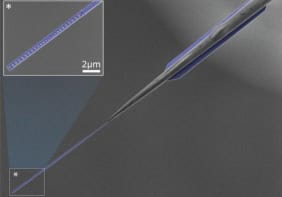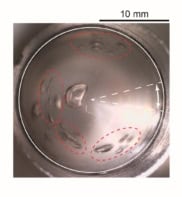Engineers in Canada have discovered a new way to generate electricity. Larry Kostiuk and colleagues at the University of Alberta pumped water through tiny microchannels in a glass disk to directly generate an electrical current (J Yang et al. 2003 J. Micromech. Microeng. 13 963). “This is the first new way to produce sustainable electricity in 160 years,” says Kostiuk. “It allows for the direct conversion of energy of moving liquid to electricity with no moving parts and no pollution.”
When a liquid, like water, comes into contact with a non-conducting solid, the solid surface becomes charged with a thin layer. The dimensions of the microchannels used in the Canadian experiments were comparable with the thickness of this charged layer. This means that if water is then forced through the channel, ions with an opposite charge to the surface preferentially pass through it, and ions with a like charge stay behind. This results in the channel becoming positive at one end and negative at the other – like a battery.
If the channel ends are connected together by a wire, current flows. Although the current through an individual channel is very small – about a nanoamp – it can be increased by forcing the water through a large number of parallel channels.
Kostiuk and co-workers used a glass disk 2 centimetres in diameter that contained 450 000 circular microchannels, each between 10 and 16 microns across. They held a reservoir of water 30 centimetres above the array and allowed it to flow through the disc under hydrostatic pressure, generating a current of 1500 nanoamps in the process. The power output could be improved by increasing the pressure drop, adjusting the size of the microchannels, decreasing the thickness of the glass disk or using a liquid with a higher salt concentration.
What might the new device be used for? “Applications are hard to foresee because we need to first characterize the voltage/current possibilities,” says Kostiuk. Potential applications could include batteries for small electronic devices such as mobile phones.



